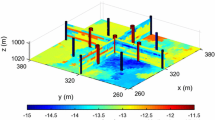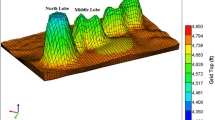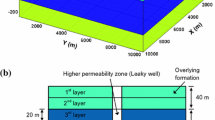Abstract
This study examined the impacts of reservoir properties on carbon dioxide (CO2) migration after subsurface injection and evaluated the possibility of characterizing reservoir properties using CO2 monitoring data such as spatial–temporal distributions of gas pressure, which can be reasonably monitored in practice. The injection reservoir was assumed to be located 1,400–1,500 m below the ground surface such that CO2 remained in the supercritical state. The reservoir was assumed to contain layers with alternating conductive and resistive properties, which is analogous to actual geological formations such as the Mount Simon Sandstone unit. The CO2 injection simulation used a cylindrical grid setting in which the injection well was situated at the center of the domain, which extended out 8,000 m from the injection well. The CO2 migration was simulated using the latest version of the simulator, subsurface transport over multiple phases (the water–salt–CO2–energy module), developed by Pacific Northwest National Laboratory. A nonlinear parameter estimation and optimization modeling software package, Parameter ESTimation (PEST), is adopted for automated reservoir parameter estimation. The effects of data quality, data worth, and data redundancy were explored regarding the detectability of reservoir parameters using gas pressure monitoring data, by comparing PEST inversion results using data with different levels of noises, various numbers of monitoring wells and locations, and different data collection spacing and temporal sampling intervals. This study yielded insight into the use of CO2 monitoring data for reservoir characterization and how to design the monitoring system to optimize data worth and reduce data redundancy. The feasibility of using CO2 saturation data for improving reservoir characterization was also discussed.









Similar content being viewed by others
References
Barnes DA, Bacon DH, Kelley SR (2009) Geological sequestration of carbon dioxide in the Cambrian Mount Simon Sandstone: regional storage capacity, site characterization, and large scale injection feasibility, Michigan Basin. Environ Geosci 16(3):163–183
Brooks RH, Corey AT (1964) Hydraulic properties of porous media. Hydrological papers, 3rd edn. Colorado State University, Fort Collins
Burdine NT (1953) Relative permeability calculation from pore size distribution data. Trans Am Inst Min Eng 198:71–78
Chen J, Hoversten GM, Vasco D, Rubin Y, Hou Z (2007) A Bayesian model for gas saturation estimation using marine seismic AVA and CSEM data. Geophysics 72(6):WA85–WA95
Doherty J (2008) PEST: model-independent parameter estimation. Watermark Numerical Computing, Brisbane
Enting IG, Mansbridge JV (1991) Latitudinal distribution of sources and sinks of CO2: results of an inversion study. Tellus 43B:156–170
Hadamard J (1902) Sur les problèmes aux dérivées partielles et leur signification physique. Princet Univ Bull 13:49–52
Hou Z, Rubin Y, Hoversten GM, Vasco D, Chen J (2006) Reservoir parameter identification using minimum relative entropy-based Bayesian inversion of seismic AVA and marine CSEM data. Geophysics 71(6):O77–O88
Hou Z, Rockhold ML, Murray CJ (2012) Evaluating the impact of caprock and reservoir properties on potential risk of CO2 leakage after injection. Environ Earth Sci 66(8):2403–2415
Hoversten GM, Cassassuce F, Gasperikova E, Rubin Y, Hou Z, Vasco D (2005) Direct reservoir parameter estimation using joint inversion of marine seismic AVA and CSEM data. Geophysics 71(3):C1–C13
Izgec O, Demiral B, Bertin H, Akin S (2008a) CO2 injection into saline carbonate aquifer formations I: laboratory investigation. Transp Porous Med 72(1):1–24
Izgec O, Demiral B, Bertin H, Akin S (2008b) CO2 injection into saline carbonate aquifer formations II: comparison of numerical simulations to experiments. Transp Porous Med 73(1):57–74
Knauss KG, Johnson JW, Steefel CI (2005) Evaluation of the impact of CO2, co-contaminant gas, aqueous fluid and reservoir rock interactions on the geological sequestration of CO2. Chem Geol 217:339–350
Loaiciga HA (1989) An optimization approach for groundwater quality monitoring network design. Water Resour Res 25(8):1771–1782
McLaughlin D (2007) A probabilistic perspective on nonlinear model inversion and data assimilation. In: Hyndman DW, Day-Lewis FD, Singha K (eds) Subsurface hydrology: data integration for properties and processes, Geophys Monogr Ser 171:243–253. American Geophysical Union, Washington, DC
Meyer PD, Valocchi AJ, Eheart JW (1994) Monitoring network design to provide initial detection of groundwater contamination. Water Resour Res 30(9):2647–2659
NOAA (2013) Trends in atmospheric carbon dioxide—Mauna Loa, Hawaii. Earth System Research Laboratory, Global Monitoring Division, National Oceanic and Atmospheric Administration, USA http://www.esrl.noaa.gov/gmd/ccgg/trends/#mlo_growth. Accessed 31 March 2013
Norbotten JM, Celia MA, Bachu S (2005) Injection and storage of CO2 in deep saline aquifers: analytical solution for CO2 plume evolution during injection. Transp Porous Med 58(3):339–360
Oldenburg CM, Unger AJA (2003) On leakage and seepage from geologic carbon sequestration sites: unsaturated zone attenuation. Vadose Zone J 2:287–296
Pruess K (2008) On CO2 fluid flow and heat transfer behavior in the subsurface, following leakage from a geologic storage reservoir. Environ Geol 54(8):1677–1686
Rutqvist J, Birkholzer JT, Cappa F, Tsang CF (2007) Estimating maximum sustainable injection pressure during geological sequestration of CO2 using coupled fluid flow and geomechanical fault-slip analysis. Energy Convers Manag 48(6):1798–1807
Tarantola A (2005) Inverse problem theory and methods for model parameter estimation. Society for Industrial and Applied Mathematics, Philadelphia
White MD, Oostrom M (2006) STOMP—subsurface transport over multiple phases—version 4.0—user’s Guide, PNNL-15782. Pacific Northwest National Laboratory, Richland
Ye W (1986) Review of parameter identification procedures in groundwater hydrology: the inverse problem. Water Resour Res 22(2):95–108
Acknowledgments
This work was supported by the US Department of Energy (DOE) Office of Science and the Pacific Northwest National Laboratory (PNNL) Laboratory Directed Research and Development project, “Uncertainty Quantification and Risk Assessment Pipeline”. PNNL is operated by Battelle for DOE under Contract DE-AC05-76RL01830.
Author information
Authors and Affiliations
Corresponding author
Rights and permissions
About this article
Cite this article
Fang, Z., Hou, Z., Lin, G. et al. Exploring the effects of data quality, data worth, and redundancy of CO2 gas pressure and saturation data on reservoir characterization through PEST inversion. Environ Earth Sci 71, 3025–3037 (2014). https://doi.org/10.1007/s12665-013-2680-9
Received:
Accepted:
Published:
Issue Date:
DOI: https://doi.org/10.1007/s12665-013-2680-9




